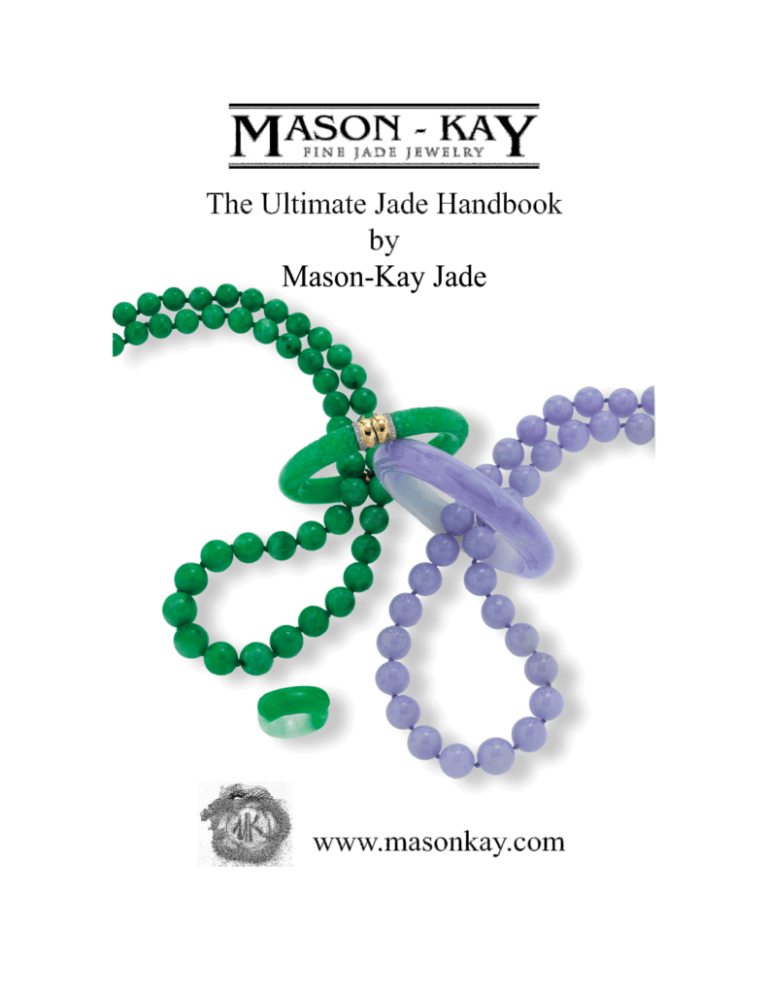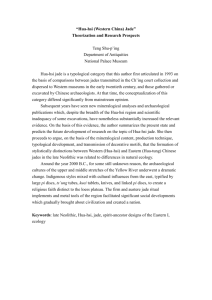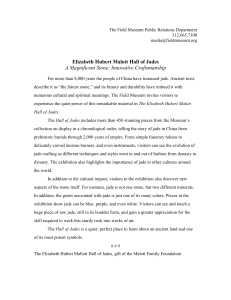
The Ultimate Jade Handbook
by
Mason-Kay Jade
Chapters
1. All About Jade
2. About Mason-Kay Jade
3. Colors Of Jade
4. Technical Characteristics & Jade Simulants Pages
5. What Is ‘B’ Jade
6. The Care and Durability of Jade
2
Chapter 1 - All About Jade
Among the oldest of known gemstones, jade
has been appreciated at many different
levels throughout history: first as an object
used in daily life, then in pagan times as an
object of ritual. Later, it acquired economic status as an item
of barter and wealth, and today it has become a medium of
art and personal adornment.
Jade refers, actually, to two chemically different stones:
jadeite, a pyroxene or a silica-bearing mineral, and nephrite,
an amphibole, or a ferro-magnesium silicate. Although
different, they share many common characteristics. The
Chinese were aware of the difference by the mid-1700's
while, in Europe, the technical differences were first
published in 1863. They are often both regarded to simply
as forms as "jade."
Nephrite jade, which the Chinese grew to appreciate so
deeply, was the form of jade that they
first encountered in the Neolithic period.
When jadeite jade was first introduced
into China, it was called Fet'Sui or kingfisher jade because of
the brilliance of colors it manifested and to distinguish it
3
from the traditional nephrite form of jade. In time, jadeite
eclipsed nephrite in terms of value, and today it is
considered gem jade. Today's fine jewelry market uses
jadeite jade almost exclusively; nephrite is generally valued
for its antiquity, carving
excellence and other historical
considerations rather than its
intrinsic material value. However,
most black jade is nephrite jade
and has become quite popular and
desirable for fine fashion jewelry.
Black jade is a much preferred
over onyx for fine jewelry. Black jade is much more durable
and lustrous than onyx. Onyx can be quite brittle and does
not retain the same value as black jade. The popularity of
green nephrite is also on the rise. Jadeite prices are on the
increase in China, so are better green nephrite prices. As the
Chinese middle class grows, so does the desire for better
jadeite and nephrite.
Apart from its technical aspects, however, there is a magic
about the stone that inspired cultures as diverse as the
Chinese, the Mayans, even the court of Czarist Russia. Its
charms elude precise definition; jade reveals itself in the
language of myth and legend. Interestingly enough, both the
4
terms jadeite and nephrite refer to the kidneys because of
early beliefs that jade was effective for diseases of the loins.
The earliest known jade used by the
Chinese (nephrite) probably came from
Turkestan, northwest of China. It wasn't
until approximately 1750 that jadeite
made its way to China from the hills of
northern Burma. At first, this brilliant
green "new" jade was regarded with
some suspicion, but soon it came to be
considered as "gem jade." In its finer qualities, it is among
the rarest stones in the world today. Nephrite, although
usually thought of as an oriental stone, was also mined and
carved in ceremonial fashion by many
cultures throughout history - notably the
Maoris of New Zealand and the welldocumented jade culture of Central
America. Modern nephrite is mined in
many places throughout the world.
Taiwan, California, Alaska, British Columbia, Wyoming, New
Zealand and Russia are the major sites. It is not a rare
stone. Jade is mined in gross boulder form from mountain
sites as well as found in the form of float. Being harder than
the material in which it is embedded, it emerges when
5
erosion removes the surrounding, softer stone. Thus it is
often found near water sources.
Typical pieces can vary from one to
two pounds to some that weigh seven
to eight tons.
It is said that the earliest jade miners were women who,
symbolizing the female or "yin" principle, would be "drawn
to" the jade, which was said to be symbolic of the male or
"yang" principle. Thus, they would find it more easily in
rivers and mountains.
Mining today proceeds much as it did in olden times - it is
unscientific at best. The monsoon season stops the whole
process for six to nine months of the year and, when the
rains clear, the locations of the sites
are often forgotten. There is one
clear improvement: large boulders
are no longer broken up at the
mining site in order to bring the
smaller, more manageable pieces to
market. We can only hazard a guess
as to how much fine material this
primitive process has destroyed
over the years. Jade lapidaries now
6
carefully saw all boulders.
MASON-KAY has been in the wholesale jade business since
1976 selling both loose jade and fine jade jewelry. In that
time, a reputation for service and quality
has been achieved. MASON-KAY also has
the ability to positively identify treated
jadeite ("B" jade) with an infrared
spectrometer. Currently, MASON-KAY is the only commercial
jade company to use infrared spectroscopy to test for
polymer impregnation. MASON-KAY offers warranty
certificates assuring the customer that all jade purchased
from MASON-KAY is natural; we do not trade in treated
merchandise. See below, in Chapter 4, how to protect
yourself against “B” jade.
7
Chapter 2 - Colors Of Jade
The Chinese identified "ritual colors" of jade and even spoke
of colors "invisible to the eye." In fact, jadeite appears in
seven basic colors, with many
variations. These are green,
lavender, red, yellow, white ,
grey, water/ice and black.
Green, the most important and
traditional color, varies
through apple green to graygreen and finally black-green.
To view Mason-Kay’s Full Jade Color Chart please click here.
There is a special magical jade stone called Imperial jade.
Although originally said to refer to those jades possessed by
the emperor and royal family, Imperial jade today should
indicate a stone whose color is a deep, translucent green,
and is without visible flaws or color variations. Such stones
are truly rare.
Lavender jade can be quite dark - almost
deep plum-purple, and in some cases can
take on a blue cast. At its other extreme,
lavender jade approaches the pink range -
8
though never achieving it - and lightens to a pale lavenderwhite. Often, lavender jade exhibits a sugary texture.
There are written reports of a blood-orange jade,
but most red jade actually ranges from a yellow
or beige to a deep russet brown.
Black jade is usually nephrite and, in its finer qualities, is
glassy black. Surface flecks are common
and difficult to avoid on pieces larger than
dime size.
Water jade and Ice jade are some of the most unique and
exquisite colors of jade. Ice jade as it infers
by the name has an icy, clear, translucent
appearance that is devoid of all color. It is
often mistaken for moonstone, but it much
more valuable, durable and beautiful. Ice
jade has a certain magical glow like no other
stone. Water jade is also translucent, but
tends to have a beautiful greenish/bluish,
watery hue.
White jade, or "pure" jade, can be found in a chalky, opaque
white to a translucent gray-white. A good polish is essential.
9
The color range for nephrite is not nearly as broad as for
jadeite and is usually characterized by a certain dullness of
color and waxiness of texture. Old stones (from Turkestan)
are sometimes creamy (mutton-fat) white while most
modern nephrite ranges from levels of gray to pure black to
an olive green. There is a coal black nephrite, which takes a
good polish, and is currently mined in Wyoming and
Australia. Black jade may appear to be a deep, rich black
color it is really a very, very dark green. If you hold a
powerful light behind black jade you will see a green tint.
Onyx will appear red.
It is often asked if there is a blue jade or a pink jade. There
is no known blue jadeite, although a
deep blue nephrite is claimed. As to
pink, most jade reported as pink is,
in fact, not jade.
Jade very often exhibits several colors within one piece.
Although one pure uniform color is usually best,
combinations such as green and lavender, red and green or
white with strong green are very desirable. The Chinese
have an extensive list of phrases to identify these
10
combinations and colors: moss-in-snow, chicken-blood,
valley-leaf, old mine, spring grass and many others.
What is the best color? Other
considerations aside, the hierarchy of
color value would be green, lavender,
red, yellow, water/ice, white and black.
This is by no means an absolute scale;
however, no one would argue with the first two. The finest
color of green jade would be close in color to a fine
Colombian emerald, but of a darker hue. In fact, the coloring
agent, chromium, is the same for jadeite and emerald. As
the green becomes lighter or darker than this standard, the
value becomes proportionately less. The same can be said of
the other colors (even black). The ideal is a strong, vibrant
color while successively darker or lighter shades are
considered less desirable.
In all cases, except white and black jade, the
degree of translucence enhances the value,
while a lack of translucence diminishes the
value. Translucence alone, in the absence of
body color, is called "water" or "crystal" or “ice” jade.
11
What causes these colors? In a nutshell, the color and
translucence of jade are the result of the chemical impurities
present in the rough and the rate at which the jade cooled
eons ago during the
formation process. For
example, green is the
result of chromic
oxide impurities;
lavender comes about
from the presence of
manganese; red jade
occurs as the end
product of oxidation
from surrounding
water or earth; black
jade denotes high iron content; white jade is "pure" jade. Of
course, jade contains many other impurities that modify and
shade these colors (quartz, mica, serpentine, etc.).
Will the color of jade change with time? In the Orient, jade is
considered a living thing that is young, then matures and
grows green with age. It was said that some people had the
ability to make jade turn green more quickly, and that this
was a virtue of their mind and body and soul. Alas,
12
interesting myths
notwithstanding, this simply will
not happen!
Many people even today believe
that in times of good health,
one's jade grows richer in color, while trauma or illness will
drain the color (and absorb the travail). The wearing of jade
close to the body was said to ensure health. Interesting
though these thoughts may be there is no evidence that
jade will change color. Quite the contrary, jade is impervious
to oils, perfumes and most cold acids. Its color is constant,
for better or worse.
13
Chapter 3 - Technical Characteristics
& Jade Simulants
Jade refers to two chemically different stones: jadeite, a
silicate of sodium and aluminum, and nephrite, a silicate of
calcium and magnesium. Although different, they share
many common characteristics. In Europe, the technical
characteristics of the two varieties were first published by
Damour in 1863; the Chinese were aware of the differences
long before.
Jadeite, the rarest and most
valuable form of jade has been
in wide use only since the mid18th century, and today is
considered the 'precious' form
of jade. Most 'fine jewelry'
items of jade consist of jadeite.
Jadeite exhibits a wide palette
of sometimes vibrant colors,
often with translucence. Green
is the most valuable color; in particular, a translucent
emerald-green is the most prized of all, and is sometimes
called 'Imperial Green'. Jadeite is also available in lavender,
red, yellow, black, water/ice and white.
14
Jade is probably the most misidentified of all important
gemstones. There are many minerals that have a passing
resemblance to jadeite and nephrite, and they are often
misrepresented as jade. The high value of jade has made it
a favorite target.
In East Asia, and elsewhere, it is not unusual to find other
"hardstones" sold as one form or another of jade. The terms
"new jade", "Hunan jade", "Sinkiang jade", "Khotan jade"
and "Korean jade" all refer to stones other than jade, as do
"Transvaal jade" and "Queensland jade".
Other common jade simulants, (opposed to "synthetics",
which are not a problem in jade),
are listed below:
Material
Comments
Also known as "Korean jade" or "Suzhou
jade". Serpentine has a somewhat fibrous
-Serpentine
texture and is often used in carvings. It is
softer than jade, with different fracturing.
R.I.=1.56
-Soapstone
Also known as steatite, or talc. This is much
15
softer than jade, and is easily scratched with
a knife- blade. It is only used for figurines.
Almost always dyed, green quartz can be the
-Green Quartz
most convincing of all jadeite simulants.
Usually seen in cabochon form, with high
luster. R.I.=1.54
Platelets of chromium mica characterizes this
form of quartz. Aventurine appears
-Aventurine
crystalline with vitreous luster. It is often cut
into beads and jewelry, but material is
usually spotty. R.I.=1.54
This is another form of quartz that is used to
simulate white jade, (nephrite), and other
-Chalcedony
colors. In its finest green form it is called
Chrysophase, and is often sold as 'Australian
jade'. Conchoidal fractures, even color.
R.I.=1.54
Long used as a jade simulant, glass is almost
always discernible by gas bubbles in its
interior, (a 10x loupe is sufficient). So-called
-Glass
"Peking glass" looks like jade until examined
closely. A Japanese product developed in the
1970's called 'meta-jade' is also glass, but
has dendrite-like inclusions.
16
Other common jade simulants are carnelian for red jade,
muscovite or zoisite for lavender jade, and bowenite
(grossularite garnet) for green jade. In addition, watch for
calcite, prehnite, idocrase, jasper, malachite and maw-sitsit.
Nephrite, the traditional form of jade, has been used for
over 5000 years by many different cultures throughout the
world. It is the Chinese, however, that raised the craft of
jade carving to an art, and who appreciated it on the
deepest levels; the rich mix of mythology and religion in
China seemed to find its highest expression in the virtues of
jade. Nephrite colors are subdued, and range from grey to
brown to blue-green to black. Translucence is rare. The
highest quality comes from Siberia, and sometimes New
Zealand or Australia. Taiwan has good nephrite, but the
giant of all producers today is British Columbia.
17
Chapter 4 - What Is ‘B’ Jade
About ‘B’ Jade
In the late 1970’s/early 1980’s, a new kind of jade appeared
in the markets of East Asia. This material had a light, bright
body color and good translucence. Some dealers noticed a
‘spidery’ texture when viewed under 20x magnification.
Prices were reasonable for such quality - too reasonable based on values at the time. This marked the beginning of
what has since been called the ‘B’ jade era, which continues
to be the most popular form of treated jade.
Buyer Beware
Consumers should purchase jade from
reliable sources only.
Jade Classifications
‘A’ Jade: Natural, untreated jadeite jade.
Only beeswax is used to fill the stone’s
Microscopic surface pores –
as has been done for centuries
‘B’ Jade: Acid-bleached, polymer-impregnated jadeite jade
18
‘C’ Jade: Acid-bleached, polymer-impregnated,
dyed jadeite jade (a dyed form of 'B' jade)
‘D’ Jade: dyed jadeite jade.
‘D’ jade almost always pre-dates the
polymer treatment era
(no polymer present)
How Can You Tell If It’s ‘B’ Jade?
Ultimately, even experts cannot be certain by eye alone
whether or not a stone is ‘A’, ‘B’, ‘C’, or ‘D’ jade. Even
standard gemological testing is usually inconclusive
(refractive index and specific gravity are either unchanged,
or insufficiently changed to make a definitive conclusion).
Hardness can be affected, but to test for it means marring
the stone permanently. So how to be certain a stone is
treated or natural?
First of all, ask. Sometimes, you might hear a
straightforward answer. If not, the biggest clue is price vs.
value. If it's too good to be true, it usually is. Also, be
suspicious if the stone exhibits brightness and translucence,
and/or is a calibrated size. Under examination with a loupe,
19
if there is a web-like consistency on the jade’s surface or if
the color appears to ‘float’ in the stone, also be wary.
In 1990 the Gemological Institute of America developed a
technique that definitively, and in a non-destructive manner,
can test for the presence of polymers within a jade’s
interior: infra-red spectroscopy. Polymers leave a tell-tale
trace in the infra-red spectrum. A machine called an infrared spectrometer can detect this trace quite clearly. MasonKay is currently the only commercial firm in the United
States equipped with its own infra-red spectrometer since
1995. Mason-Kay is well known for its testing and evaluation
services to the jewelry industry.
What About Disclosure?
With full disclosure, the selling of 'B' jade is acceptable.
However, many retailers and wholesalers in the US and
abroad continue not to disclose. As of April 2001, the FTC
(Federal Trade Commission) changed the jewelry guidelines
for gem enhancement to require disclosure.
How is ‘B’ Jade Made?
Poor quality jade rough with internal ‘staining' or structural
flaws is immersed in a powerful acid (sulfuric or
hydrochloric) which is sometimes heated to increase its
20
strength. This emersion process can be repeated and can
last for several weeks. The working fumes are quite toxic
and this procedure is not without risk. The resulting stone
has now been changed: the sodium in the sodium silicate of
jade’s structure has been leached out and with them the
internal stains. At this point, many experts say, the stone is
no longer jadeite jade at all. The stone is then put into a
neutralizing agent, after which a polymer is injected into the
stone with the use of a centrifuge. The stone is then entirely
covered with a hard, clear plastic-like coating. Cutting and
polishing are then performed as they would be on any jade
stone.
Is 'B' Jade as Durable as Natural Jade?
No. ‘B’ jade can, in time, become unstable and often
discolor. In contrast to natural jade's renowned durability,
'B' jade can be so brittle as to fracture with only minimal
impact. Heavy prongs or bezels can actually penetrate the
weakened surface of the treated stone. Even ordinary
household detergents and simple acetone (used for cleaning
& removing natural jade from glued settings) can break
down the polymer. There are even reports of ‘acid leaks’
from improperly neutralized stones which can result in skin
burns.
21
How Much is ‘B’ Jade Worth?
For some, ‘B’ jade has no value because it is no longer truly
jade. Its value is considered to be approximately 5% to 10%
of the value of its ‘A’ jade equivalent. The value of ‘C’ and ‘D’
jade is worth between $5-$50.
Chemistry has the ability to change and transform the
nature of the materials around us, including precious stones.
Diamonds are fracture-filled and synthesized, rubies and
sapphires are heated and simulated, emeralds are oiled and
laboratory grown, topaz is irradiated by fissionable material
and star sapphires have been synthetically made for over
fifty years. It is not surprising that jade is amenable to
chemical manipulation. Some would say that it makes the
real thing all that much more precious!
Red Jade can be heated to increase the redness, but the
usual result is a dull brown, and translucence is lost. This
process, by the way, is irreversible. Lavender can pose
somewhat of a problem; it has a long history of being dyed
in a form of "blueberry juice." In some cases, dyed lavender
can be spotted right off (in fractured material, dye will
accumulate in fissures); but it is not always possible to
detect dyed lavender by eye alone. Most dyes fade with time
and exposure to sunlight. We recommend buying from a
22
reputable source from which one has recourse.
Common jade fakes include serpentine (also bowenite),
carnelian, aventurine quartz, glass, grossularite, idocrase
and soapstone. This is not a complete list. Bear in mind that
materials known as new jade, Honan jade, Korean jade,
metajade and Sinkiang jade are almost never actually jade.
The term jade is synonymous with "precious" in Chinese and
thus "korean jade" may be no more jade than a "golden
sunset" contains gold. Again, know your dealer.
23
Chapter 5 – The Care and Durability Of Jade
Next to Hematite or "black diamond", Jade is the toughest
of all known stones. This extreme durability explains its
early use, by many cultures, as tools for farming and
hunting. No other stone appears in such a wide variety of
forms; bangles, hololith rings, statuary cups,
spoons and scepters. It is jade's unparalleled
toughness that accounts for its wide variety
of uses, and it is this very toughness that allows for the
unmatched delicacy of carving one finds in jade.
The care of jade is quite simple. The proper way to clean
jade is to simply apply a mild, soapy water solution. A small,
soft bristled toothbrush is best for cleaning the crevices
within carvings. It is important to
heed this advice. Most common
jewelry cleaners and techniques can
cause problems. Jewelry that
appears to be bezel set is most
often secured by a combination of
metal and epoxy. The metal is
tightened around the stone and then
the jeweler applies the epoxy. This extra precaution is taken
because jade rarely has a sharp edge, as most other faceted
24
gemstones, to be held by metal alone. Many other nonfaceted stones (i.e. opals, coral, pearls, turquoise, etc.)
require similar demands.
What other stone can be carved as a
continuous chain from a single piece
of material and endure as jewelry or
statuary for centuries? Because of
its toughness and hardness, jade
even appeals to the aural senses, for
it’s is said when "jade is struck, it
rings true." It is this same durability
that allows a family to pass on a cherished piece from
generation to generation and elevates jade from the realm
of an ordinary gemstone to a priceless heirloom.
Below is a list of “Dont's” for Jade:
• Never steam jade – Jewelers usually
steam faceted stones after sizing and
working on pieces. Please remind
your jeweler of this frequent error.
• Never use Ultra-sonic jewelry
equipment and cleaning solutions on
jade.
25
• It is best to remove your jade before swimming in a
chlorine treated pool, the ocean, or soaking in a hot
tub.
• A warning for gardeners – please remove your jade
rings before messing with any dirt and soil. The quartz
dust in soil is a powerful abrasive.
© 2011 Mason-Kay, Inc. All Rights Reserved
26









